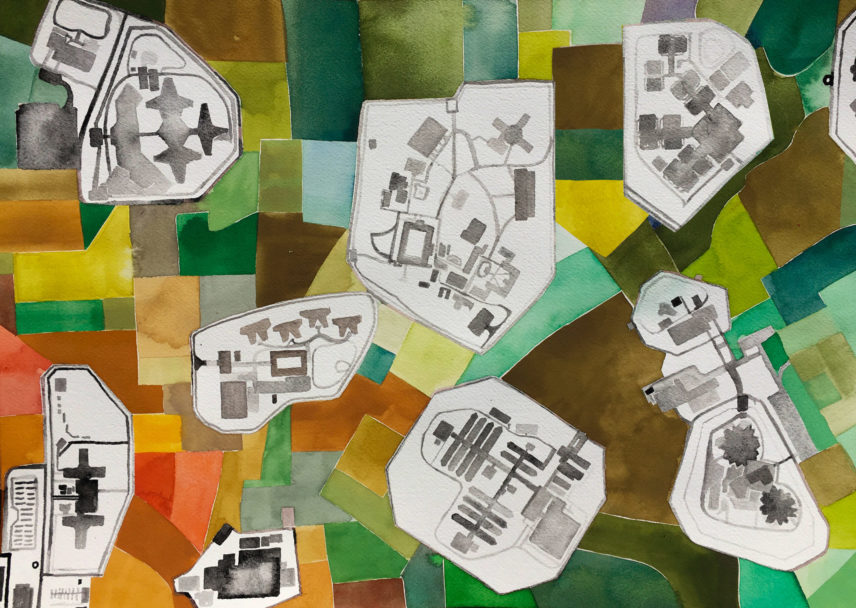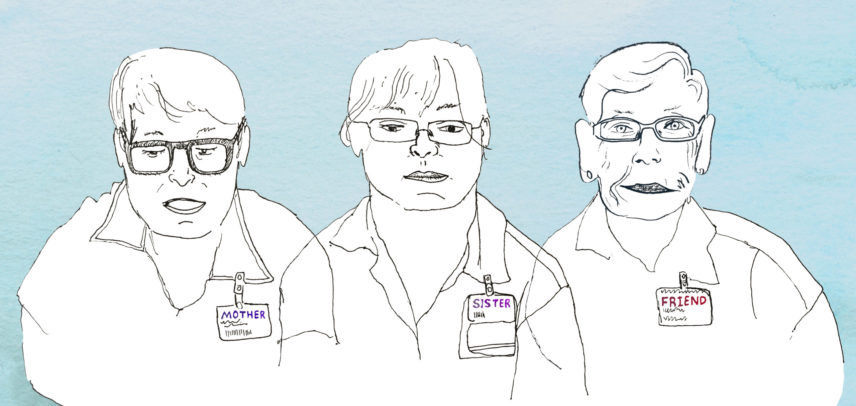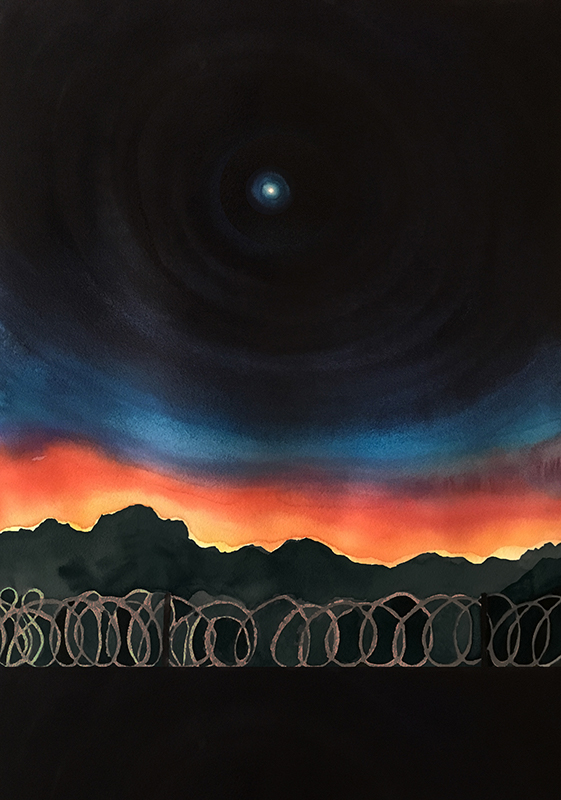Article begins
My walls were riddled with bullet holes, made by the very man who claimed to love me. He used his guns to intimidate, threaten, and control. He told me no one else would want me or think I was pretty, and he beat me to ensure my disfigurement.
What little hope I had left held my walls together. I hoped he would change, that my children would be safe, and that the pain would go away. Those walls crumbled down.
His abuse carried over to my children. He choked my son when he was just six years old. After I came to prison, my son went on a choking spree—he was choking his siblings, other kids, and we didn’t know what was wrong with him. They brought him here to visit me and I said, “Son, why are you doing this?” He bawled and screamed, and he said, “Because if I hurt someone I can come to prison and I’ll be with you.”
—Mel V.
Prisons in the United States are a complex patchwork of more than 6,700 institutions: federal, state, and military prisons; county and city jails; immigrant detention centers; juvenile facilities; state forensic hospitals; jails and prisons under tribal and Bureau of Indian Affairs control; and detention facilities in US territories (Sawyer and Wagner 2019). These are a wide-ranging array of walls, buildings, fences, and razor wire—a carceral architecture that traverses the nation.
Some are tucked away on rural backroads, like my former research site on the high, dry plains of central New Mexico. Others are urban, adjacent to a downtown courthouse or on the hollowed-out edges of a rustbelt city like Dayton, Ohio, where I have worked with incarcerated women for nearly five years. The walls and fences encircling the Dayton prison are porous enough for odors from a nearby garbage dump to breeze through, which tells us something about the geographies and politics of prison siting as well as how we regard the people contained inside.

Who is hidden away inside these walls? At any given moment, about 2.2 million people are imprisoned in the United States. Population counts hide the enormous churn through local jails, where stays are short—there are 10.6 million jail admissions each year (Sawyer and Wagner 2019). Although racial disparities have narrowed, they are still stark. Black Americans comprise 40 percent of the incarcerated population but just 13 percent of people in the United States. Approximately 10 percent of prisoners are women, but they remain the fastest growing segment of the prison population.
These are important, yet partial, truths about imprisonment. They do not tell us much about the many threads of the carceral state that weave through the social, political, and economic fabric of life in the United States. Nor do they tell us who the people inside are, and how they make sense of their circumstances. Prison walls render them invisible and severely curtail their communication with people outside.
Visual artist Forest Bright and I invited women serving life sentences, with whom we have been collaborating for two years, to consider “walls” with us. Seven of them offer written reflections about the nested and interconnected walls that flow through their lives; this essay emerges out of many conversations and drafts.
Observing while being observed. Those words describe the daily world of anyone inside prison walls. People build mental walls to survive imprisonment. I have become a master builder of walls over decades of incarceration.
I realized I had walls when I was free. Even as a child I had my “secret safe haven.” Prison walls give you so much time to think and remember.
I choose to look above the prison walls and razor wire and see the blue skies, feel the warm sunshine on my face. This gives me the strength push through the mental walls I construct.
Walls do not have to mean stop, but push through and keep going.
—Inza
To choose or not to choose, that is a very good question. In prison, people constantly say, “You made a choice to be here.” Did I?
I don’t know why I chose to do something so horrible that sent me behind these walls. I believe it was because I didn’t realize I had a choice.
Here is what I know: I chose life over death, and that choice cost me a life sentence, a life away from my family. I wasn’t given a choice to choose the prison walls, they were chosen for me.
—DaRyndA
Taken together, their writings say so much. First, prison walls have been society’s primary intervention into the structural violence that they’ve endured. The walls in their homes bore witness to, and sometimes offered refuge from, sexual and physical violence when families, communities, and the state all failed to protect them. For most women sentenced to life, histories of victimization are tied directly or indirectly to their convictions. When incarcerated women say things like “prison walls saved my life,” they speak less to the conditions inside—which include racial and gendered violence, routinized humiliation, and medical and other forms of neglect (see Price 2015; Davis 2002)—than to the precarity and lack of safety that defined their pre-incarceration lives.
Second, many women chose to emphasize the emotional and psychological walls that they build. These walls are about survival. Some constructed them, brick by brick, from childhood. These walls help them contend with long prison sentences; reckon with loss, trauma, and abandonment; and struggle with existential uncertainties about if and when they will be released. In some cases, the walls protect them from the parts of themselves that they are not ready to face.
I was bullied as a child. I used to hide behind an old stone wall that surrounded an elderly woman’s house. If the boys who chased us tried to climb over, she scared them off. I felt safe behind that wall.
Later, I married an abusive man and I locked myself in the bathroom to feel safe, surrounded by those walls.
Today I am grateful to be in a prison that has cells rather than dorms because I can escape the chaos and shut everyone out. Once again, walls allow me to improvise a safe zone.
The most important walls keep out the memory of the day I did something horrible. These walls keep me safe from knowing what doing drugs ultimately made me do. Maybe someday I will be strong enough or curious enough to seek help to tear them down, but for now my walls are my refuge.
—Roxanne
Third, they resist allowing prison walls, and all that they signify, to define their existence. “I am a mother. I am a sister. I am a daughter. I am a wife. I am a grandmother. I am a friend.” I hear versions of this over and over, like a refrain, from incarcerated women. They remind their listeners, and perhaps themselves, that they are embedded in important and socially valued relationships. It is a rhetorical way of asserting their humanity, of talking back to the forms of dehumanization that the walls both facilitate and hide.
They resist, too, by articulating what Robin D. G. Kelley might call “freedom dreams.” They are hopeful. They make meaning in the day-to-day while also conjuring other lives, beyond their walls, in “the somewhere in advance of nowhere” of their imaginations (Kelley 2002: xii, citing poet Jayne Cortez).

In his analysis of executions as performance practice, Dwight Conquergood (2002) explores the crucial role of spectators in Puritan public hangings. Audience identification with the condemned as “fellow sinners”—a sense of “there but for the grace of God, go I”—was central to the ritual’s efficacy (351). A Puritan ethos “that embraced wrongdoers as members of the same moral community…was superseded in the nineteenth century by a gothic view of criminals as ‘moral aliens’ and ‘moral monsters’” (ibid.). This marks a striking societal transformation away from collective and relational experiences of “deviance” toward a framework characterized by othering, revulsion, and contempt. Individualism and alienation are inscribed in modern punishment rituals: the life sentence, the sanitized lethal injection.
Today’s prison walls materialize this shift. They offer a veneer of simplicity that homogenizes the diversity of the people they confine—people awaiting trial, people scooped up for public order offenses, people who have been wrongfully convicted, people serving time for non-violent offenses, and people who crossed borders seeking safety as well as people who have caused violent harm. Yet regardless of their story, just by virtue of being on the other side of the wall, all prisoners occupy the status of dangerous, criminal other. It becomes easy to turn them into scapegoats, to project onto them the (mostly white) public’s fears and anxieties.
Stone by stone
I build a wall A view too painful to describe
Bloody screams
discordant voices
Bathroom floors comfort me, like a womb Stone by stone
My heart is ossified Delusions, bought and prescribed
The more I took, the more I could hide
Warm bodies between my thighs,
No names, no feelings Stone by stone
This wall, cold and hard
I believed no one could see inside
First child murdered by his father in a rage
Stone by stone
Second child taken by SIDS
You are a bad mother Stone by stone
Drugs become my lover
My pimp, my abuser
A third beautiful child has met his brothers
Shackles and chains
No more denial
when old walls tumble
the system builds new ones
Stone by stone Dark cells
Cold nights
A child’s death saved my life
No more tracks in my veins
No more lines up my nose
No more fistfights with my loves
Stone by stone
Walls wear down
Light peeks through
I am choosing to live.
—Naẽ
Most of the women serving life sentences had no prior interactions with the legal system. Many reflect on the naiveté of their pre-prison beliefs: all people in prison were bad; I thought I would never end up here. They issue warnings: “It can happen to anyone.” They want me and their other “outside” interlocutors to understand that “there but for the grace of God, go I.” They draw attention to the startling normality of incarcerated people, to the many positive qualities that they and their sisters hold. They challenge the binary constructions of us versus them, good versus bad, and victim versus perpetrator by talking about their own lives and calling out everyone else: we are all of us all these things at once.
Walls, prisons among them, are politically expedient responses to a host of complex, seemingly intractable social problems. Yet the people who bear the disproportionate burden of those problems—poverty, lack of safety, racism, or misogyny, to name a few—are far more likely to be imprisoned.
Are my walls insanity or sanity? Are they healthy or unhealthy? I know my walls are my way of protecting myself, but they are also barriers in my relationships.
People make promises they don’t keep. “M” said, “No matter what I’ll be your friend forever.” He told me he’d always be there. But five weeks after getting out of prison, he disappeared. Up goes the wall.
I put up walls to protect myself from pain—whether real or imagined. I think I am protecting my sanity, but is that sane? I got so focused on keeping people out that I wear blinders. I may not see a good person or situation because I don’t want to become vulnerable and take a chance at getting hurt. Maybe building walls is insanity.
—Pandora
Prison walls kept me safe from drugs, unhealthy relationships, and of course my cousin. One day I woke up with my cousin on top of me, with my breast in his mouth. We fought for a while, he won that round.
I felt like I was going crazy. I started using drugs and, for that moment, I didn’t have to feel the madness. I went to rehab for three days, then I was on my own. I returned home for a few months and then caught this case. Here I sit.
When I came to prison I was lost, confused. Today I know I am a child of God who loves helping others any way I can. I have dreams and goals. These walls saved me.
—Sarai
To actually address the problems that walls purport to solve would require fundamental shifts in collective thinking, political will, and public policies. It would require reinventing our relationships with each other, with ourselves, and with the destructive processes that allow, normalize, and perpetuate oppression. It requires a radical kind of love that reaches across difference, and undermines systemic privilege: to have regard for everyone’s safety and dignity, to provide everyone with food and medical care, to guarantee education and opportunity for all people, and to invest in all families and communities.
There are small but growing transformative and restorative justice movements that are reconceiving “justice” and “accountability” in the United States (just a few organizations include Bay Area Transformative Justice Collective; Common Justice; INCITE!; Restorative Justice for Oakland Youth; Philly Stands Up; Zehr Institute; Critical Resistance). They offer more collective, more supportive, less punitive ways of dealing with harm that emphasize healing and reconciliation (see Sered 2019). Perhaps most importantly, they allow us to imagine and bring into being a world beyond prisons.

*All incarcerated collaborators chose how their names would appear.
Forest Bright is visiting assistant professor of visual art at Antioch College in Yellow Springs, Ohio.
Cite as: Steinmetz, Emily, DaRyndA, Inza, Mel V., Naẽ, Pandora, Roxanne, Sarai, and Forest Bright. 2019. “I Choose to Look Above the Prison Walls…” Anthropology News website, November 15, 2019. DOI: 10.1111/AN.1313

